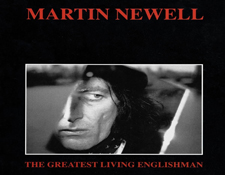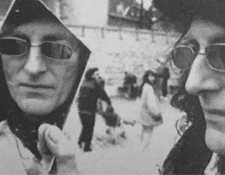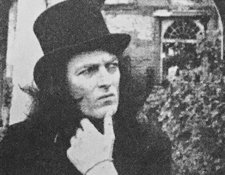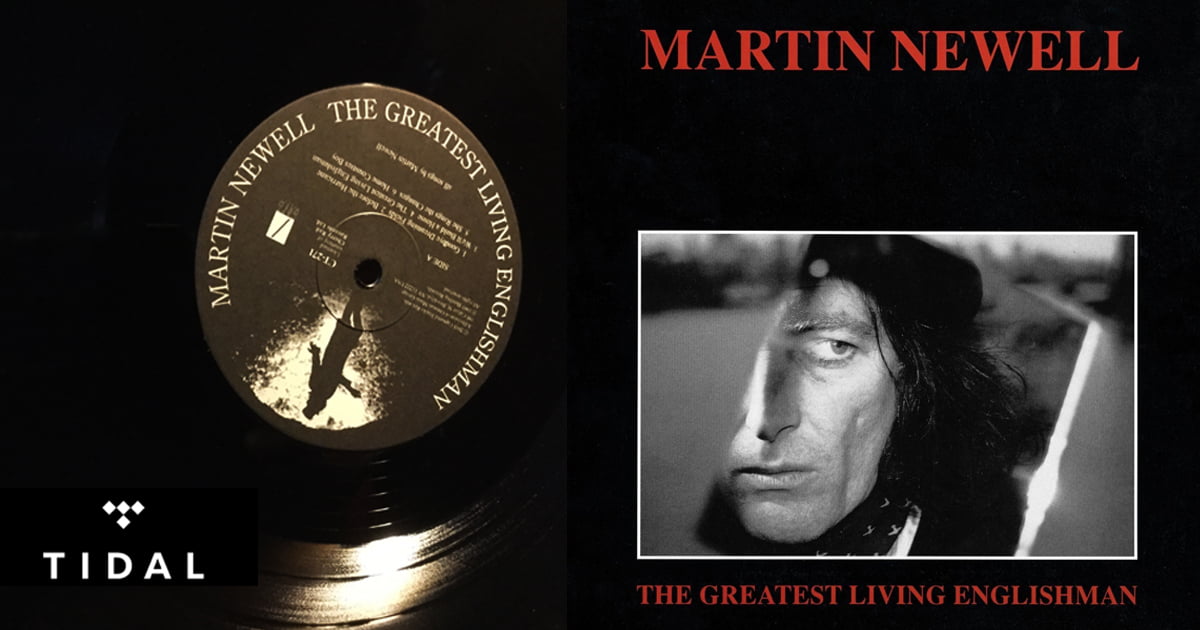It’s the time of year for saving money!
Assuming that most of you reading this review have never heard of Martin Newell and his wonderful (just-reissued-on-first-time-vinyl) album The Greatest Living Englishman, I’m going to first try to tempt you with the promise of a recording chockfull of exemplary songs, rich melodies, jangling electric and acoustic guitars — as well as the presence of members of XTC and The Damned — before talking about anything remotely audiophile-esque.
 Because… at the end of the day, Dear Readers… its all about the music and this album contains wondrous amounts of the stuff. Never you mind how Martin Newell (of The Cleaners From Venus) got hooked up with XTC’s Andy Partridge (all detailed in new liner notes included with the new LP) and the two were inspired to create this British rock-pop classic, Newell’s Revolver, if you will. Just give a listen to the songs: “Goodbye Dreaming Fields” sounds like what might happen if mid-60s Beatles jammed with The Beach Boys and The Byrds. “We’ll Build A House” is a heartbreaking tale with an aching melody that works its way deep into your spine before Andy Partridge lets loose on your brain with one of his finest guitar solos.
Because… at the end of the day, Dear Readers… its all about the music and this album contains wondrous amounts of the stuff. Never you mind how Martin Newell (of The Cleaners From Venus) got hooked up with XTC’s Andy Partridge (all detailed in new liner notes included with the new LP) and the two were inspired to create this British rock-pop classic, Newell’s Revolver, if you will. Just give a listen to the songs: “Goodbye Dreaming Fields” sounds like what might happen if mid-60s Beatles jammed with The Beach Boys and The Byrds. “We’ll Build A House” is a heartbreaking tale with an aching melody that works its way deep into your spine before Andy Partridge lets loose on your brain with one of his finest guitar solos.
Never mind the bollocks, here’s Martin Newell!
Seriously folks, this is one of my favorite records from the 1990s, an album that has never grown tired. It actually grows on me more and more after every listen. The Greatest Living Englishman pushes all the right buttons, at least it does for this reviewer.
 The title track, “The Greatest Living Englishman” feels like a lost Village Green era Kinks song, by way of Badfinger, SMiLE-era Brian Willson/Beach Boys and The Cowsills’ “The Rain, The Park and Other Things.” “Street Called Prospect” is a fine update on the Kinks’ “Dead End Street” concept replete with Harpsichord, shuffling drums and haunting harmonies. There is even a jingle-jangly holiday song tucked away on side two “Christmas In Suburbia” with fab Farfisa Organ pads perking up the mix. Speaking of jangle, the song “The Jangling Man” is great little rocker with loads of layered up acoustic and electric guitars, chiming twelve strings and (probably something like) a Rickenbacker (guitar) in there somewhere.
The title track, “The Greatest Living Englishman” feels like a lost Village Green era Kinks song, by way of Badfinger, SMiLE-era Brian Willson/Beach Boys and The Cowsills’ “The Rain, The Park and Other Things.” “Street Called Prospect” is a fine update on the Kinks’ “Dead End Street” concept replete with Harpsichord, shuffling drums and haunting harmonies. There is even a jingle-jangly holiday song tucked away on side two “Christmas In Suburbia” with fab Farfisa Organ pads perking up the mix. Speaking of jangle, the song “The Jangling Man” is great little rocker with loads of layered up acoustic and electric guitars, chiming twelve strings and (probably something like) a Rickenbacker (guitar) in there somewhere.
So, yeah, this is record rich with British roots… deep buckets full of harmonies and many pints full of English-accented lead vocals. This is the real deal. No one here is trying to be Little Richard or Chuck Berry or Lou Reed or Joey Ramone for that matter. If this album sounds like any group in particular, that finger might point to producer Andy Partridge’s band, XTC and their alter-ego The Dukes of Stratosphear. I’ll put it this way: if you liked XTC’s Todd Rundgren-produced smash hit Skylarking a lot, you may very well enjoy this record — it is a sort of indie rock, home brewed, made-in-the-garden-shed-studio (literally!) labor of love with that pastoral feel documenting days in the life of one Englishman’s life.
 A poor man’s Pet Sounds, perhaps? A pauper’s Sgt. Pepper? You’re getting close. How about indie rock’s Dark Side of the Moon? Well, that might be stretching the point a bit but I think it gives you some idea of what to expect here: the whole album does really flow as a continuous listening experience, a song cycle in that sense with clever interlinks that create a enveloping mood, start to finish. Actually, if you take a step back to explore a project driven by early Pink Floyd producer Norman Smith, The Pretty Things’ Parachute (which I reviewed here) is a very fair parallel in many ways. Be sure to listen for The Damned’s Captain Sensible rip up the lead guitar on the epic closer “The Green-Gold Girl of the Summer” (Warning: extreme psychedelic left-right back and forth panning alert!).
A poor man’s Pet Sounds, perhaps? A pauper’s Sgt. Pepper? You’re getting close. How about indie rock’s Dark Side of the Moon? Well, that might be stretching the point a bit but I think it gives you some idea of what to expect here: the whole album does really flow as a continuous listening experience, a song cycle in that sense with clever interlinks that create a enveloping mood, start to finish. Actually, if you take a step back to explore a project driven by early Pink Floyd producer Norman Smith, The Pretty Things’ Parachute (which I reviewed here) is a very fair parallel in many ways. Be sure to listen for The Damned’s Captain Sensible rip up the lead guitar on the epic closer “The Green-Gold Girl of the Summer” (Warning: extreme psychedelic left-right back and forth panning alert!).
As to what format you might want to listen to this recording in, that really depends on your needs and wants. Up on Tidal there is only a CD quality version of the album (with the later issue cover art). It sounds just OK there, I have to admit. My original CD sounds surprisingly fuller and less compressed, with more defined stereo separation and such. This is no doubt one of those early 90s digital era recordings but the artist and producer clearly had analog intentions in their creation, so the album actually sounds genuinely warm and comforting.
So while you won’t hear the London Symphony Orchestra recorded at Abbey Road here, you will hear wonderful rich samples of symphonic harps and strings which sound fabulous (“Before The Hurricane”).
Back to the question of which version do you go for, to this reviewer’s ears this is very much a “good, better, best” type situation akin to Goldilocks and the Three Bears. While the CD makes for pretty comfortable listening, the vinyl version delivers a softer, gentler, more snuggly presentation of the music. This “warmth” is perhaps quite honestly a function of the playback via my Music Hall MMF 7.1 turntable and Goldring 2400 cartridge run through a nice little Bellari tube pre-amplifier. The vinyl quality is very good, dead quiet and perfectly centered so someone at Captured Tracks Records was paying attention to important details. You even get a beautiful 10-page, LP sized booklet with photos, lyrics and notes from Mr. Newell on how this album came about (you can peruse the booklet online too in a neat interactive version by clicking here). There is no download included but if you need a digital version you can buy the CD easily and it is available in that form on Amazon and iTunes.
 Whatever it is, the difference in the sound is perhaps subtle but yet palpable. Something to consider for some of you out there in audiophile land. Since this is a multi-track recording mostly made by two people in a garden shed, don’t expect a huge sound stage and such. But what this recording may lack in audiophile depth it more than makes up for it with rich earworms, memorable hooks, groovy riffs and lush melodies for the ages.
Whatever it is, the difference in the sound is perhaps subtle but yet palpable. Something to consider for some of you out there in audiophile land. Since this is a multi-track recording mostly made by two people in a garden shed, don’t expect a huge sound stage and such. But what this recording may lack in audiophile depth it more than makes up for it with rich earworms, memorable hooks, groovy riffs and lush melodies for the ages.
The Greatest Living Englishman may not become your favorite demo disc, but it may well become one of your favorite records to play again and again and again.
And isn’t that ultimately what its all about, folks?









